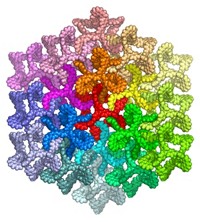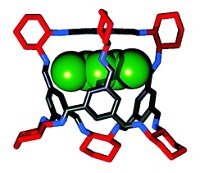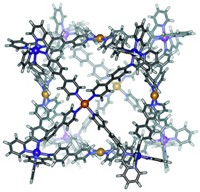Advertisement
Grab your lab coat. Let's get started
Welcome!
Welcome!
Create an account below to get 6 C&EN articles per month, receive newsletters and more - all free.
It seems this is your first time logging in online. Please enter the following information to continue.
As an ACS member you automatically get access to this site. All we need is few more details to create your reading experience.
Not you? Sign in with a different account.
Not you? Sign in with a different account.
ERROR 1
ERROR 1
ERROR 2
ERROR 2
ERROR 2
ERROR 2
ERROR 2
Password and Confirm password must match.
If you have an ACS member number, please enter it here so we can link this account to your membership. (optional)
ERROR 2
ACS values your privacy. By submitting your information, you are gaining access to C&EN and subscribing to our weekly newsletter. We use the information you provide to make your reading experience better, and we will never sell your data to third party members.
Physical Chemistry
Cubic Assembly Encloses Nanovoid
Bulky groups enable macrocycles to pack as nanocubes rather than columnar stacks
by Michael Freemantle
October 24, 2005
| A version of this story appeared in
Volume 83, Issue 43

A novel zinc phthalocyanine compound self-assembles in solution to form a crystalline material containing interconnected solvent-filled cubic voids having nanometer dimensions (Angew. Chem. Int. Ed., published online Oct. 5, dx.doi.org/10.1002/anie.200502668).
Neil B. McKeown, professor of organic materials chemistry at Cardiff University, in Wales, says he and his coworkers achieved the precise enclosure of space on the nanoscale by the simple recrystallization of a readily prepared phthalocyanine derivative from acetone to give a cubic packing arrangement in which six of the extended square-shaped molecules self-assemble to define the nanovoid.
Each nanovoid contains over 80 molecules of solvent, which we exchanged for other solvents, even water, he continues. The voids are therefore interconnected, and the clathrate is able to act as a nanoporous material.
The work is a beautiful example of crystal engineering, according to Russell E. Morris, chemistry professor at the University of St. Andrews, in Scotland. Overall, the paper shows how far we have come in learning how to engineer the structures of materials to produce large pores and voids that may be used as nanosized chemical storage devices and nanoreactors, he says.
Phthalocyanines, such as copper phthalocyanine, are produced in bulk in industry for use as pigments in paints and printing inks, and as plastic colorants. They are also used in solution as homogeneous catalysts—for example, in the large-scale removal of sulfur impurities from crude oil. As solids, phthalocyanines do not make good heterogeneous catalysts because the large, flat molecules aggregate face-to-face, forming columnar stacks like rolls of coins. As a result, only a few metal ions are exposed.
The Cardiff team used molecular modeling to show that face-to-face aggregation can be avoided by placing 2,6-diisopropylphenoxy groups on the peripheral positions of the phthalocyanine ring. The substituents protrude from the macrocycle plane and thus prevent formation of columnar stacks. Instead, the phthalocyanines form crystals that contain large molecular boxes.
The team followed a literature procedure, a simple two-step synthesis, to prepare the bright green zinc phthalocyanine clathrate in high yield from two commercially available compounds: 4,5-dichlorophthalonitrile and 2,6-diisopropylphenol.
X-ray diffraction analysis revealed that the crystal structure is cubic, with a cavity volume of at least 8 nm3. The enclosed volume in other reported crystalline clathrates, and also in discrete molecular cages and network coordination polymers, rarely exceeds 1 nm3, according to the team members.
The phthalocyanine core has a shallow cone shape with a central Zn2+ ion. The oxygen atom of an axial water ligand on the ion protrudes from the molecular plane, pointing to the center of the cube. The unit cell has a further 24 water molecules associated through hydrogen-bonding interactions to the phthalocyanine ring.
The authors note that, relative to other reported hydrogen-bonded clathrate structures, the proportion of included solvent within the crystal structure is unremarkable. However, its distribution into such large, well-defined cavities is unprecedented, they add.
Small openings at the corners of the cube allow the enclosed solvent molecules to be replaced by another solvent. This means that the material is not only pretty but might also have some properties that make it useful, for example in separation technology, Morris says. Replacing the metal at the center of the phthalocyanine with other metals might also allow some chemical reactivity to be engineered into the boxes themselves.

Since writing the paper, McKeowns group has shown that catalytically active cobalt ions can be incorporated into the same structure. We can even visualize directly by X-ray crystallography the exchange of axial ligands—for example, pyridine for water—on the metal ions, McKeown says.
The potential of a system containing well-defined active metal ions at precise and accessible locations within the crystal structure is that every metal ion will count, and each will behave in the same way, he adds. Most heterogeneous catalysts made by, say, treating a zeolite with a metal salt, have a mix of different oxidation states, and the metal ions are in different places in the crystal lattice. Therefore, a system like the cubic crystal should allow better control of reactivity and selectivity, and give more reproducible results.
However, we still have a long way to go to develop a useful, practical material, he says. For example, we need to improve the stability of the material when it is removed from the crystallization solvent.
The team is now attempting to stabilize the structure by placing polar and hydrogen-bonding substituents on the peripheral 2,6-diisopropylphenoxy units.





Join the conversation
Contact the reporter
Submit a Letter to the Editor for publication
Engage with us on Twitter